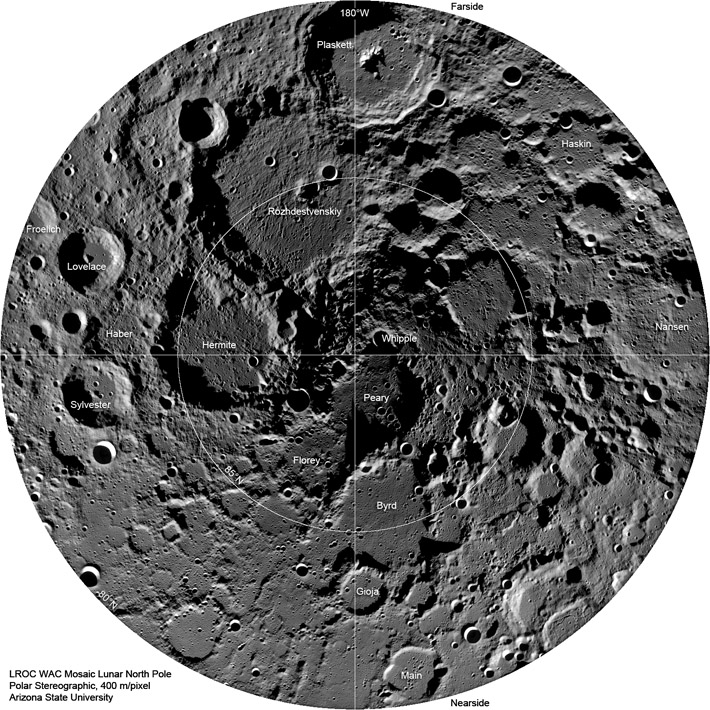Difference between revisions of "October 12, 2010"
| (4 intermediate revisions by the same user not shown) | |||
| Line 1: | Line 1: | ||
__NOTOC__ | __NOTOC__ | ||
=Northern Exposure= | =Northern Exposure= | ||
| + | <!-- Start of content --> | ||
<!-- ws:start:WikiTextHeadingRule:1:<h1> --> | <!-- ws:start:WikiTextHeadingRule:1:<h1> --> | ||
<!-- ws:start:WikiTextLocalImageRule:16:<img src="/file/view/LPOD-Oct12-10.jpg/169622939/LPOD-Oct12-10.jpg" alt="" title="" /> -->[[File:LPOD-Oct12-10.jpg|LPOD-Oct12-10.jpg]]<!-- ws:end:WikiTextLocalImageRule:16 --><br /> | <!-- ws:start:WikiTextLocalImageRule:16:<img src="/file/view/LPOD-Oct12-10.jpg/169622939/LPOD-Oct12-10.jpg" alt="" title="" /> -->[[File:LPOD-Oct12-10.jpg|LPOD-Oct12-10.jpg]]<!-- ws:end:WikiTextLocalImageRule:16 --><br /> | ||
<em>image from [http://lroc.sese.asu.edu/news/index.php?/archives/290-The-Lunar-North-Pole.html#extended LRO-WAC] [NASA/GSFC/Arizona State University]</em><br /> | <em>image from [http://lroc.sese.asu.edu/news/index.php?/archives/290-The-Lunar-North-Pole.html#extended LRO-WAC] [NASA/GSFC/Arizona State University]</em><br /> | ||
<br /> | <br /> | ||
| − | The Wide Angle Camera of the Lunar Reconnaissance Orbiter is producing wonderful new mosaics of the entire surface. A South Pole view [ | + | The Wide Angle Camera of the Lunar Reconnaissance Orbiter is producing wonderful new mosaics of the entire surface. A South Pole view [[October_5,_2010|recently]] appeared, and here is its companion from the opposite pole. This is a significant improvement over the existing Lunar Orbiter [http://planetarynames.wr.usgs.gov/images/Lunar/lac_1_lo.pdf mosaic]. It includes names of the larger craters but some of the smaller, more recently named ones don't appear. The most spectacular crater - Plaskett - is over the top, invisible on the farside, but I always feel a sense of accomplishment in recognizing Challis and Main and then on to Gioja and Byrd. Some of these polar craters contain ice deposits on their permanently dark floors, but visual observers see no evidence except the shadows. <br /> |
<br /> | <br /> | ||
<em>[mailto:tychocrater@yahoo.com Chuck Wood]</em><br /> | <em>[mailto:tychocrater@yahoo.com Chuck Wood]</em><br /> | ||
<br /> | <br /> | ||
<strong>Related Links</strong><br /> | <strong>Related Links</strong><br /> | ||
| − | Rükl plate [ | + | Rükl plate [https://the-moon.us/wiki/R%C3%BCkl_4 4]<br /> |
<br /> | <br /> | ||
<hr /> | <hr /> | ||
| − | < | + | <table class="wiki_table"> |
| − | < | + | <tr> |
| − | ---- | + | <td> <!-- RemoveRevolverMaps --> |
| − | + | <!-- RemoveRevolverMaps --> | |
| − | + | </td> | |
| + | <p><b>Yesterday's LPOD:</b> [[October 11, 2010|Lonesome Limb]] </p> | ||
| + | <p><b>Tomorrow's LPOD:</b> [[October 13, 2010|Little Marked Mare]] </p> | ||
| + | <!-- End of content --> | ||
| + | {{wiki/ArticleFooter}} | ||
Latest revision as of 18:55, 13 October 2018
Northern Exposure

image from LRO-WAC [NASA/GSFC/Arizona State University]
The Wide Angle Camera of the Lunar Reconnaissance Orbiter is producing wonderful new mosaics of the entire surface. A South Pole view recently appeared, and here is its companion from the opposite pole. This is a significant improvement over the existing Lunar Orbiter mosaic. It includes names of the larger craters but some of the smaller, more recently named ones don't appear. The most spectacular crater - Plaskett - is over the top, invisible on the farside, but I always feel a sense of accomplishment in recognizing Challis and Main and then on to Gioja and Byrd. Some of these polar craters contain ice deposits on their permanently dark floors, but visual observers see no evidence except the shadows.
Chuck Wood
Related Links
Rükl plate 4
Yesterday's LPOD: Lonesome Limb
Tomorrow's LPOD: Little Marked Mare
COMMENTS?
Register, Log in, and join in the comments.



